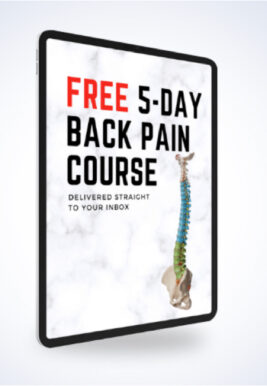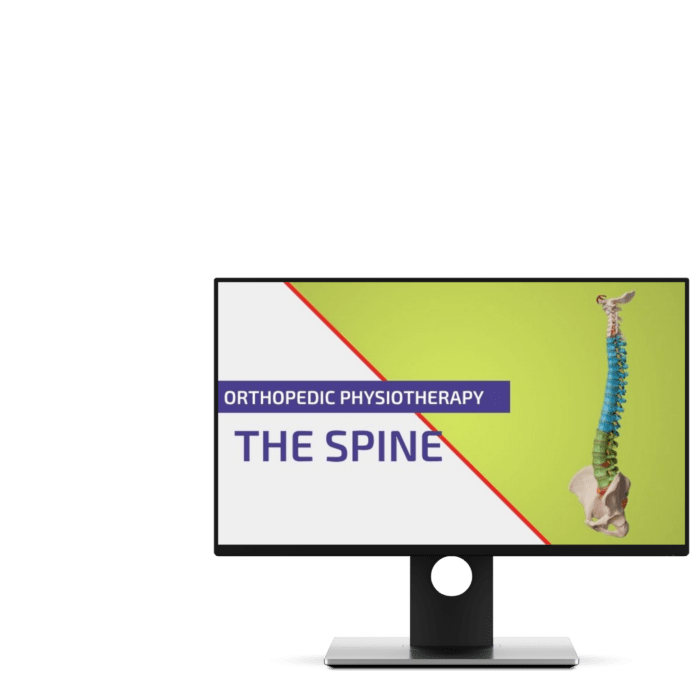Thoracolumbar Syndrome | Diagnosis & Treatment

Thoracolumbar Syndrome | Diagnosis & Treatment
Introduction & Pathophysiology
Patient’s who present with low back pain, but also ipsilateral gluteal and groin pain may be experiencing referred pain from spinal nociception from the thoracolumbar junction, abbreviated as TLJ. Robert Maigne first described thoracolumbar syndrome in 1974, which is why this syndrome is commonly known as Maigne’s syndrome.
Pathomechanism
The TLJ may be more susceptible to biomechanical disturbance due to lower stability compared to the thoracic spine as the last two ribs not being attached to the sternum. Furthermore, it is an area where the alignment of the facet joints changes from the frontal plane in the thoracic facets to the Sagittal plane in the lumbar facets. This transitional position might make the TLJ more susceptible to overload.
The pathomechanism is similar to that of lumbar facet syndrome. Irritation of the facet joints and/or articular capsule and/or excessive paraspinal muscle tone may cause irritation of neural structures and produce clinical symptoms.
These neural structures are the dorsal rami, but also the ventral rami of the lower thoracic and upper lumbar nerve roots from T11 to L2.
Follow a course
- Learn from wherever, whenever, and at your own pace
- Interactive online courses from an award-winning team
- CEU/CPD accreditation in the Netherlands, Belgium, US & UK
Clinical Picture & Examination
Next to tenderness upon palpation and pressure of the TLJ, irritation of the dorsal rami in the TLJ area can refer pain to the unilateral iliac crest and upper gluteal region. Irritation of the ventral rami of the TLJ region can lead to unilateral pseudovisceral pain in the hypogastric area, false sciatic neuralgia, tenderness of the pubic symphysis, and hypersensitivity of the intestines.

Pain is triggered by extension and/or rotation and does not cross the body’s midline as the nociceptive structures are only innervated unilaterally.
Examination
Be aware that Maigne’s syndrome is a rather rare clinical pattern. It is therefore advisable to first exclude the lower lumbar spine, the SI joint, and the hip as the responsible areas of nociception. The following orthopedic tests or test batteries are recommended to exclude these areas:
- A quick screening test for all 3 regions: Menell Test
- Sacroiliac Joint: Cluster of Laslett
- Hip Joint: FADDIR Test
- Lumbar Spine: PIVMS in prone position
Next to tenderness of palpation of the TLJ, the iliac crest should be palpated for tenderness. Move 7 centimeters laterally from the midline and rub the crest in an up-and-down motion on the posterior iliac crest point. This should elicit sharp pain as the irritated cutaneous branches of T11-L1 are compressed.

Maigne suggests comparing the sensitivity difference on the iliac crest, the inguinal canal, or the greater trochanter by rolling and tightening the skin on both sides. In the Kibler Fold Test, the examiner raises a fold of skin between the thumb and forefinger and rolls it along the trunk perpendicular to the course of dermatomes. The patient should experience more tenderness and hyperesthesia on the affected side compared to the healthy one.

At last, it has to be mentioned that TLJ syndrome is diagnosed clinically as most radiological studies will be normal and false positive results are common. Only a diagnostic nerve block in which the affected facet joint is injected with local anesthesia is described to be useful to confirm the hypothesis.
Free 5-Day Back Pain Email Course

Follow a course
- Learn from wherever, whenever, and at your own pace
- Interactive online courses from an award-winning team
- CEU/CPD accreditation in the Netherlands, Belgium, US & UK
Treatment
Originally, Maigne proposed manipulative therapy for the TLJ region. Furthermore, Alptekin et al. (2017) showed that steroid injections and exercise were able to decrease pain. No hard recommendations can be given at this point as hard evidence is rather scarce.
The following thoracic mobilization exercises might be a treatment option:
References
Follow a course
- Learn from wherever, whenever, and at your own pace
- Interactive online courses from an award-winning team
- CEU/CPD accreditation in the Netherlands, Belgium, US & UK
How to Master Treating Spinal Conditions in Just 40 Hours


What customers have to say about this online course
- Shachaf Alexander19/07/24Orthopedic Physiotherapy of the Spine Orthopedic Physiotherapy of the spine
Interesting course packed with useful data and practical tools.
I highly recommend.Verena Fric25/11/22Orthopedic Physiotherapy of the Spine GREAT COURSE ABOUT THE SPINE
great course, best overview about the different syndromes of the spine, very helpful and relevant for the work with patients - Peter Walsh01/09/22Orthopedic Physiotherapy of the Spine 5 starsChristoph21/12/21Orthopedic Physiotherapy of the Spine Really a well done course, using the modern ways of teaching. Compliments! Sometimes for me you entered too much into details instead of touching more important chapters of Spine treatment like techniques for the treatment of muscles and fascias
- John09/10/21Orthopedic Physiotherapy of the Spine EXCELLENT COURSE HIGHLY RECOMMEND
As a newly graduated physiotherapist i highly recommend this course just to know you are on the right track with your patients. the information presented is very clear and easy to follow as well as the great physiotherapy style videos. It makes learning actually fun , thanks guys for all your hard work. Well deserved.Alexander Bender06/09/21Orthopedic Physiotherapy of the Spine During the corona crisis, I booked many online courses and webinars, but none were as entertaining and well thought out as PhysioTutors’ courses.
All units are well summarized, meaningfully broken down and easy to understand.
I am looking forward to the other courses.
Many greetings from Germany. - GHADEER05/01/21Orthopedic Physiotherapy of the Spine VERY INFORMATIVE AND UPDATED
for anyone who is lost in handling spine cases, this course is very helpful.MICHAEL PROESMANS20/12/20Orthopedic Physiotherapy of the Spine HIGHLY METHODICAL, WITH PLENTY OF SCIENTIFIC REFERENCE
Clear, structured and well researched course concerning most common pathologies of the spinal complex.
Plenty of informative modules, with detailed video-analysis.
If you’re looking for a course to study in your own time, with enough depth and scientific background, then you’ve found a very good one here.
Bang for buck, a great course. - BENOIT08/05/20Orthopedic Physiotherapy of the Spine After finishing the Orthopedic course for Lower & Upper limbs, I was looking forward to begin this Spine specific course.
Really good overview about all spine pathologies from epidemiology to diagnosis & treatment which made me more confident to care for my future patients.
ANOTHER GREAT COURSE !
The courses are well detailed with lot of informations and videos.
For me these 2 courses are must to see to learn and update knowledge for most common pathologies in Physiotherapy.Nicolas Cardon27/04/20Orthopedic Physiotherapy of the Spine This is a very interesting course !
We can find many informations about the main pathologies and their differential diagnosis and about objective and subjective exam. Videos are clear and well designed.
It’s a very well course for these who wish complete their Orthopedic Manual Therapy curriculum.
A French Physio’







